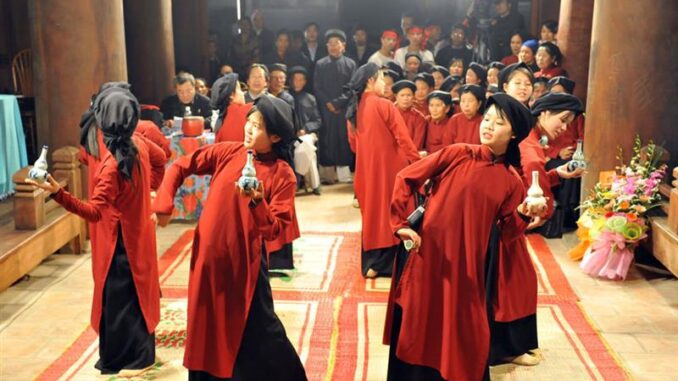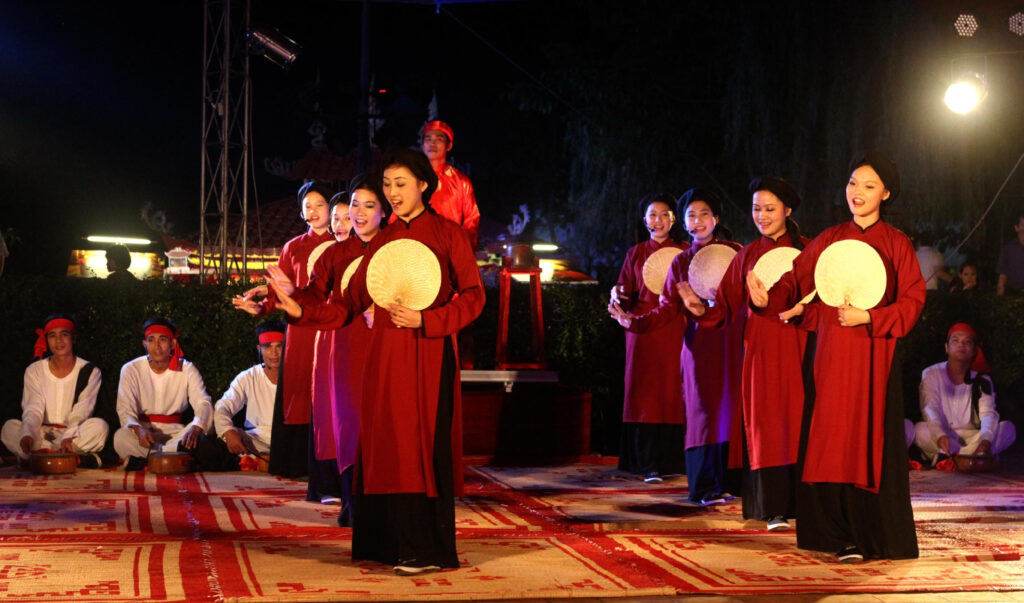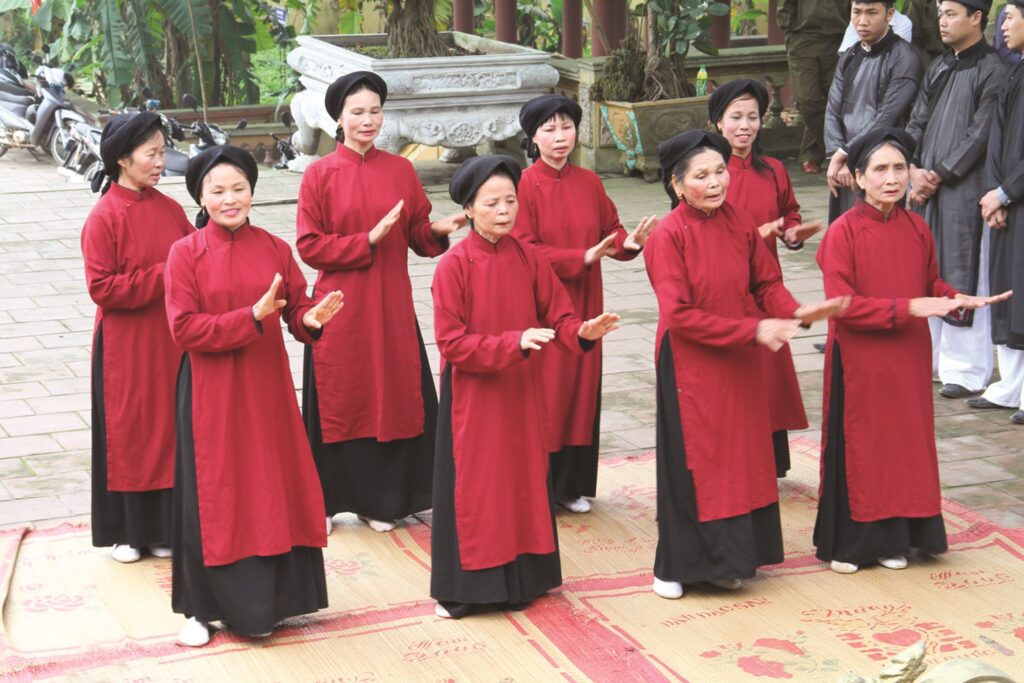
Xoan singing is a precious intangible cultural heritage of the Land of the Ancestors, associated with the worship of Hung Kings, a belief from the Vietnamese practice of ancestor worship. According to researchers, the Xoan singing heritage of Phu Tho and the Hung King worshiping belief are two but one, linked together. The idea of worshiping Hung Vuong exists and is promoted thanks to the ritual of Xoan singing.
The original Xoan villages in Phu Tho province all originated from ancient towns in the center of the ancient Van Lang country, so Xoan singing still preserves many historical and cultural elements of the dawn of the nation-building era.
For a long time, Xoan singing has been associated with festivals and the spiritual needs of people’s lives.
History
Relating to the origination of Xoan singing, there have been a lot of legendary stories handed down from generation to generation one of which says: once upon a time, in spring, King Hung, during his travel seeking an area to construct a citadel, saw a small group of herd boys and girls playing and singing “dong dao” – an oral folk poetry of children in Vietnam. The king talked to them and taught them the songs and dances of Lac Viet people (the ancient Vietnamese). To commemorate the king’s merit, the villagers built a temple, called Lai Len (now located in Kim Due Commune, Viet Tri City, Phu Tho Province) to worship the king. Since then, villagers usually offered the king banquets on the 30th day of the 12th lunar month and performed worship songs from the 1st to the 5th days of the New Year’s first lunar month to commemorate what the king taught them, praying for a new peaceful and prosperous year.
Cultural value
Xoan singing appears as part of the creed of the local inhabitants who engaged in wet rice agriculture in Phu Tho – the ancient land of the Vietnamese nation where many folk festivals were held annually in the spring. Xoan singing contains characteristics of an agricultural culture.
Xoan singing conveys two cultural messages: one is a spiritual aspect (worshipping, wishing, and praying), and the other is a festive aspect (romantic singing in festivals for lovers).

Regarding rituals, Xoan singing is for worshiping ancestral Hung Kings, manifesting the Vietnamese cult of worshiping their ancestors and expressing their wishes for luck, prosperity, and a good life. Consequently, the lyrics of Xoan singing represent the moral philosophy between the king and his people. Xoan singing consists of sweet and romantic melodies with profound meanings. The song lyrics show not only the feelings between husband and wife, between father and his children but also the thoughts and wishes of the community, being a bridge of solidarity in the community.
The combination of ritual singing and love-exchange singing, existing for a very long time and loved by many generations ensures the vitality of Xoan singing.
Elements of art
Xoan singing is a combination of poetry, music, singing, and dancing. Xoan singing is accompanied by dancing and musical instruments like clappers and drums. There exists a tight attachment between the poem and the musical rhythm, the meaning of poem unites with music.
Song Lyrics
The song lyrics are quite clear about the cult of worshiping ancestors and gods and also reflect the belief in fertility (tin nguong pho thuc) of the Vietnamese community. Besides, they also mention the power of royalty, scholars, farmers, workers, traders, or love of couples…
Most Xoan songs were composed following poetry styles such as four-word verse, five-word verse, six-eight-word verse, seven-seven-six-eight-word verse, seven-beat verse, and free-word verse.
Scale of Notes
The performance of Xoan singing is determined by Vietnamese language intonation, including six different tones (no tone mark, rising tone, falling, low glottal, rising glottal, falling-rising). Most Xoan songs use a five-note scale, some use a three-note scale and a four-note scale with a simple rhythm.

Melodies
Xoan singing has three types: recital melody (hat noi), chanting melody (hat ngam ngoi), and praising melody (hat xuong).
The lyrics of the recital melody are often poems of four-word or five-word verses. Normally, a recital melody uses a two-note to five-note scale (not over an eight-note scale) with few ornaments. The style of the recital melody is rustic, simple, clear, and strong.
Meanwhile, chanting a melody is usually free and smooth, expressing deep emotions. This type of singing uses more ornaments than recital melody.
Finally, praising melody combines the characteristics of recital melody and chanting melody, composing a song using various methods such as repeating, changing, imitating, etc.
Rhythms
Rhythms interact with other elements of Xoan singing logically. Ritual songs (Giao Trong, Giao Buo, Tho incense, Dong dam) and songs with lyrical dances (So bo, Mo ca, Bom gai) usually go together with clear and connected rhythms. Mixed rhythms do exist but are not popular (Tho nhang, Dong dam). Songs with chanting melody as Gai hue. Hat phu has a free rhythm. A typical characteristic of Xoan singing rhythm is oblique stresses used in many such as Giao Trong, Giao Buo, Tho incense, Xin hue- do chu, etc.
Preservation and conservation

In recent years, preserving and promoting the value of Xoan singing heritage has received special attention from Phu Tho province. Up to now, the entire cultural space for practicing Xoan singing heritage in the original Xoan wards has been completely repaired and restored. 20/30 cultural space relics practicing Xoan singing have been restored, meeting the requirements for practicing Xoan singing heritage.
Traditional festivals associated with Hung King Worship and Xoan singing are maintained and restored, creating a cultural space for the community to practice, perform, and pass on heritage. From having only 7 artisans capable of teaching to now, the whole province has nearly 100 artisans capable of teaching and 300 successor artisans.
Xoan singing was also brought back to the community, promoting the community’s role in preserving the singing from the Hung King period. From the original Xoan wards, Mon Dinh song has spread throughout 13 districts and cities and the entire province currently has 34 provincial clubs with over 1,500 people participating in practicing Xoan singing. Xoan singing is also practiced in 64 district-level Xoan and folk singing clubs, and 42 commune-level Xoan and folk singing clubs.
Conclusion
With outstanding global values, on November 24, 2011, at the 6th Conference of the Intergovernmental Committee on the Conservation of UNESCO’s Intangible Cultural Heritage held in Bali (Indonesia), Xoan-Phu Tho singing of Vietnam was recognized as an Intangible Cultural Heritage in need of urgent protection of humanity.
On December 8, 2017, at the 12th Conference, the Intergovernmental Committee for the Protection of Intangible Cultural Heritage of UNESCO officially removed Phu Tho Xoan Singing from the state of emergency protection and became a Representative intangible cultural heritage of humanity.
Get an opportunity to visit Intangible World Cultural Heritage in Vietnam through Vietnam E-Visa!